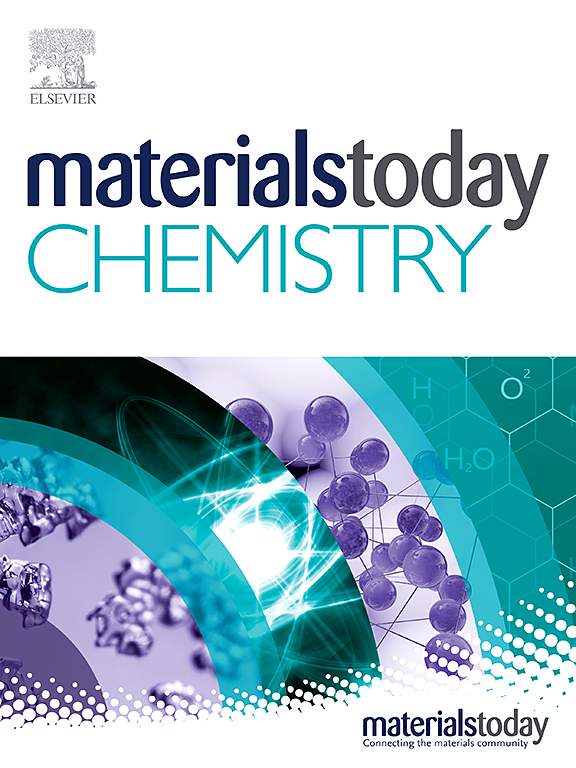Ti3C2Tx MXene quantum dots coated hollow manganese dioxide nanoparticles for tumor combination therapy and magnetic resonance imaging
IF 6.7
2区 化学
Q1 CHEMISTRY, MULTIDISCIPLINARY
引用次数: 0
Abstract
Chemodynamic therapy (CDT) is a new cancer treatment that uses low-valence transition metal ions to catalyze intracellular Fenton/Fenton-like reactions, producing hydroxyl radicals (•OH) to eliminate cancer cells. However, achieving satisfactory therapeutic outcomes with CDT alone can be challenging. In this work, we reported an anticancer drug delivery DOX@HMDN-TQDs@PEI-PEG (DMTP) based on hollow mesoporous manganese dioxide nanoparticle (HMDN), which has the potential to improve cancer therapy by combining synergistic therapeutic and tumor magnetic resonance imaging (MRI) capability. After loading the anticancer drug doxorubicin hydrochloride (DOX), the pores of HMDN were sealed with polyethyleneimine (PEI) modified TiCT MXene quantum dots (TQDs) and finally modified with polyethylene glycol (PEG) to obtain the final system. HMDN depletes glutathione (GSH), which is harmful to CDT, in cancer cells, and generates Mn that can be used for both CDT and MRI. TQDs can also be used for highly effective photothermal therapy (PTT) that enhances CDT. The combination of DOX with chemotherapy can significantly inhibit tumor growth. In addition, DMTP combines the capability of tumor MRI as Mn is also a -weighted contrast agent. This multifunctional delivery system provides new ideas for research related to tumor diagnosis and treatment.涂覆空心二氧化锰纳米粒子的 Ti3C2Tx MXene 量子点用于肿瘤联合治疗和磁共振成像
化学动力疗法(CDT)是一种新型癌症治疗方法,它利用低价过渡金属离子催化细胞内的芬顿/芬顿样反应,产生羟基自由基(-OH)来消除癌细胞。然而,仅用 CDT 来达到令人满意的治疗效果可能具有挑战性。在这项工作中,我们报道了一种基于中空介孔二氧化锰纳米粒子(HMDN)的抗癌药物递送DOX@HMDN-TQDs@PEI-PEG(DMTP),它结合了协同治疗和肿瘤磁共振成像(MRI)能力,具有改善癌症治疗的潜力。在载入抗癌药物盐酸多柔比星(DOX)后,HMDN 的孔隙被聚乙烯亚胺(PEI)修饰的 TiCT MXene 量子点(TQDs)密封,最后被聚乙二醇(PEG)修饰,得到最终的系统。HMDN 会消耗癌细胞中对 CDT 有害的谷胱甘肽(GSH),并生成可用于 CDT 和 MRI 的锰。TQDs 还可用于高效光热疗法 (PTT),从而增强 CDT。将 DOX 与化疗结合使用可显著抑制肿瘤生长。此外,由于 Mn 也是一种加权造影剂,因此 DMTP 结合了肿瘤核磁共振成像的功能。这种多功能给药系统为肿瘤诊断和治疗相关研究提供了新思路。
本文章由计算机程序翻译,如有差异,请以英文原文为准。
求助全文
约1分钟内获得全文
求助全文
来源期刊

Materials Today Chemistry
Multiple-
CiteScore
8.90
自引率
6.80%
发文量
596
审稿时长
33 days
期刊介绍:
Materials Today Chemistry is a multi-disciplinary journal dedicated to all facets of materials chemistry.
This field represents one of the fastest-growing areas of science, involving the application of chemistry-based techniques to the study of materials. It encompasses materials synthesis and behavior, as well as the intricate relationships between material structure and properties at the atomic and molecular scale. Materials Today Chemistry serves as a high-impact platform for discussing research that propels the field forward through groundbreaking discoveries and innovative techniques.
 求助内容:
求助内容: 应助结果提醒方式:
应助结果提醒方式:


